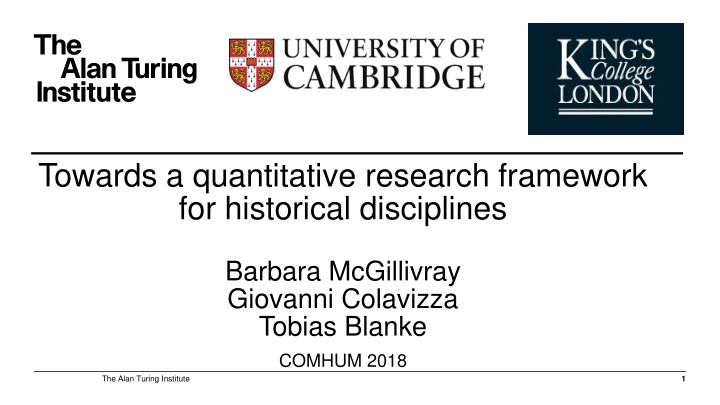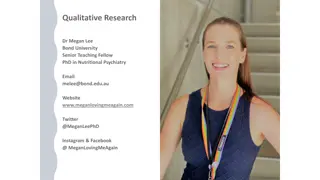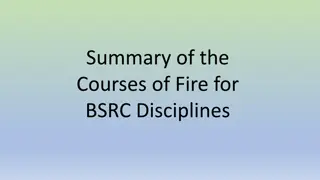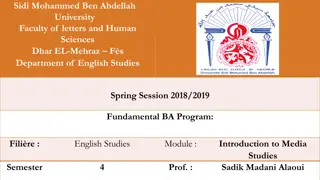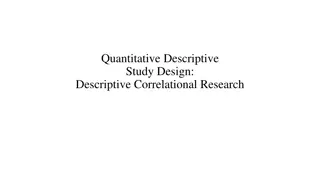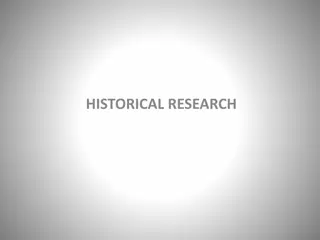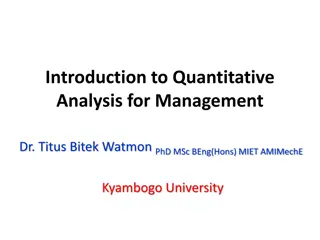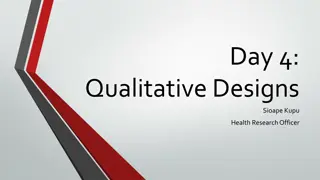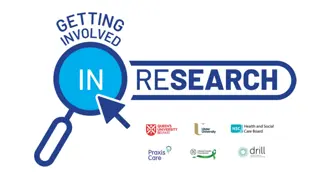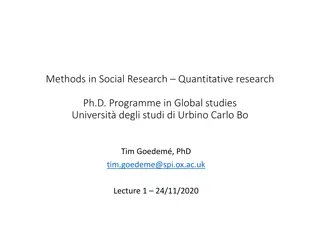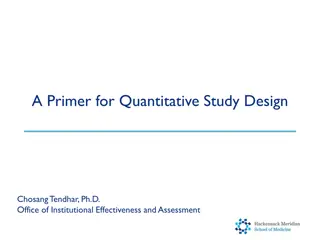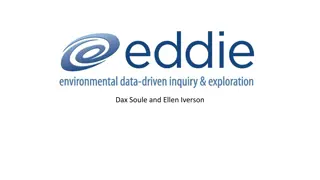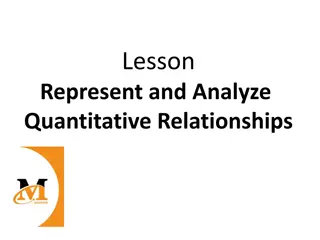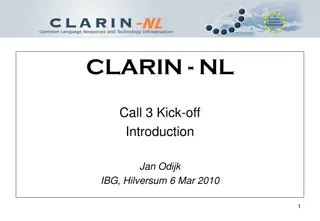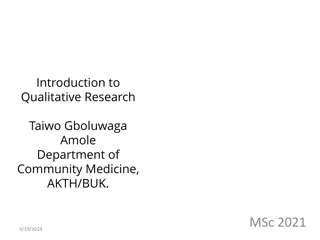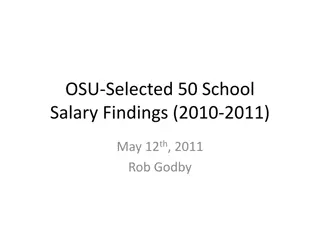Quantitative Research Framework for Historical Disciplines
Scholarly communities in historical disciplines are combining quantitative and qualitative methods to study phenomena that change over time. The proposed general methodological reflection aims to enhance research in historical linguistics through quantitatively driven models and claims. Quantitative historical linguistics emphasizes gathering quantifiable evidence from primary sources to make statements based on evidence and develop formalized representations of phenomena, leading to consensus within the scholarly community.
Download Presentation

Please find below an Image/Link to download the presentation.
The content on the website is provided AS IS for your information and personal use only. It may not be sold, licensed, or shared on other websites without obtaining consent from the author.If you encounter any issues during the download, it is possible that the publisher has removed the file from their server.
You are allowed to download the files provided on this website for personal or commercial use, subject to the condition that they are used lawfully. All files are the property of their respective owners.
The content on the website is provided AS IS for your information and personal use only. It may not be sold, licensed, or shared on other websites without obtaining consent from the author.
E N D
Presentation Transcript
Towards a quantitative research framework for historical disciplines Barbara McGillivray Giovanni Colavizza Tobias Blanke COMHUM 2018 The Alan Turing Institute 1
Quantitative research and historical disciplines Different scholarly communities, different reactions Historical disciplines: closed corpora phenomena that change over time combine quantitative and qualitative methods - - - - - We propose a general methodological reflection - The Alan Turing Institute 2
The starting point The first and (so far) only general framework for historical linguistics Inspired by Carrier (2012) The Alan Turing Institute 3
Quantitative historical linguistics Assumptions - The linguistic historical reality is lost - aim of quantitative research: models of and claims on such reality, quantitatively driven from evidence and lead to consensus among the scholarly community Scope - where quantifiable evidence can be gathered from primary sources Jenset & McGillivray (2017: 45 ff.) The Alan Turing Institute COMHUM 2018 4
Quantitative historical linguistics Claims - - Statements based on evidence Possess strength proportional to that of the evidence supporting them Models - - - Formalized representations of a phenomenon (statistical or symbolic) Research tools embedding claims or hypotheses They produce novel claims and hypotheses Jenset & McGillivray (2017: 45 ff.) The Alan Turing Institute COMHUM 2018 5
Quantitative historical linguistics: research workflow Jenset & McGillivray (2017: 45) The Alan Turing Institute COMHUM 2018 6
Extension to historical disciplines What happens with historical data and research? What do we need to change? - - The Alan Turing Institute 7
Case study 1 (Blanke and Wilson 2017) UK Government White Papers from 1945 to 2010 888 documents with 19.3 million words in total Mid-level abstraction, between theoretical debates by intellectuals and intellectually- minded politicians and laws, regulations, guidance documents, instructions and so on In previous work we could automatically detect changes in meaning, but the epochs themselves were not machine-read The Alan Turing Institute 8
Case study 2: Apprenticeship in early modern Venice ~55000 contracts from the end of the XVIth century to mid XVIIIth. Publicly registered to certify their successful completion in view of mastership and guild membership. Results here based on a smaller sample In collaboration with Maud Ehrmann, Riccardo Cella, Anna Bellavitis, Valentina Sapienza et al. The Alan Turing Institute 9
Case study 2: Apprenticeship in early modern Venice Payments from/to master highlight an interesting 3-modal distribution: Many apprentices receive a payment Many do not Some pay their master in turn Question: what is happening? How is the apprenticeship used in practice? Hypothesis: double-track system. You can pay to get more training, or you can be paid and act as cheap workforce. NB reality probably blurred! In collaboration with Maud Ehrmann, Riccardo Cella, Anna Bellavitis, Valentina Sapienza et al. The Alan Turing Institute 10
Case study 2: Apprenticeship in early modern Venice OLS regression points to: 1. Shorter contracts entailed a higher payment to the apprentice. 2. Older apprentices were paid more. 3. Incremental and regular payments were higher than a single payment at the end of a contract. 4. Venetians were paid less than foreigners, and less frequently. Outcome: support for the presence of working contracts masked as apprenticeships. In collaboration with Maud Ehrmann, Riccardo Cella, Anna Bellavitis, Valentina Sapienza et al. The Alan Turing Institute 11
Case study 2: applying the framework Primary sources: a single one, publicly registered contracts of apprenticeship. Annotated evidence: filter formulary and construct a database. Quantitative distributional evidence: numerical or categorical data. Hypotheses: coming from examples, comparisons and previous literature. Relation model - historical linguistic reality: the double-track is plausible. 1. 2. 3. 4. 5. The Alan Turing Institute 12
Case study 2: lessons learnt 1. Quantification usually applicable only to few sources, while many other remain relevant (laws, guild rules and practices, jurisprudence, etc.). 2. Modelling results need to be interpreted in context. They especially help to bound the space of reasonable hypotheses under consideration. The Alan Turing Institute 13
Attempts at some answers Conclusions: 1. The scope of primary evidence is broader in history than linguistics 2. The scope for a purely quantitative approach is more limited in history than linguistics Map the use of quantitative methods in historical disciplines, towards a more general framework for historical disciplines The Alan Turing Institute 14
Thanks! bmcgillivray@turing.ac.uk gcolavizza@turing.ac.uk tobias.blanke@kcl.ac.uk The Alan Turing Institute 15
Quantitative historical linguistics Jenset & McGillivray (2017: 23 ff.) The Alan Turing Institute COMHUM 2018 16
Quantitative historical linguistics: principles Principle 1: Consensus To achieve the aim of quantitative historical linguistics research, it is necessary to reach consensus among those scholars who accept the premises of quantitative historical linguistics. Principle 2: Conclusions All conclusions in quantitative historical linguistics must follow logically from shared assumptions and evidence available to the historical linguistics community. Principle 3: Almost any claim is possible Every claim has a non-zero probability of being true, unless it is logically or physically impossible. Principle 4: Some claims are stronger than others There is a hierarchy of claims from weakest to strongest. Principle 5: Strong claims require strong evidence The strength of any claim is always proportional to the strength of evidence supporting it. Principle 6: Possibly does not entail probably The inference from possibly to probably is not logically valid. Jenset & McGillivray (2017: 45 ff.) The Alan Turing Institute COMHUM 2018 17
Quantitative historical linguistics: principles Principle 7:The weakest link The conclusion is only as strong as the weakest premise it builds on. Principle 8: Spell out quantities Implicitly quantitative claims are still quantitative and require quantitative evidence. Principle 9: Trends should be modelled probabilistically Quantitative historical linguistics can rely on different types of evidence, but only quantitative evidence can serve as evidence for trends. Principle 10: Corpora are the prime source of quantitative evidence Corpora are the optimal sources of quantitative evidence in quantitative historical linguistics. Principle 11:The crud factor Language is multivariate and should be studied as such. Principle 12: Mind your stats Jenset & McGillivray (2017: 45 ff.) Quantitative analyses of language data must adhere to best practices in applied statistics. The Alan Turing Institute COMHUM 2018 18
